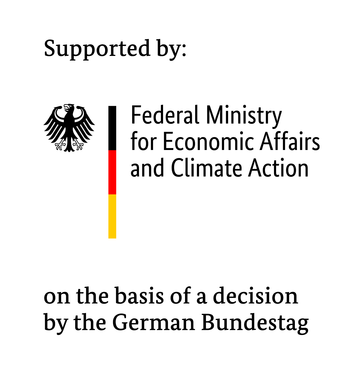You are here: / Home
All-in-one device for freeze-drying and production of biomaterial

Federal Ministry for Economic Affairs and Climate Action
05/2022-10/2024
René Kretschmer
+49-351-4081-5119
with automated freezing and sterilisation option
The aim of the R&D project is to develop an automatic freeze-drying system with cryobiological freezing function, oxidation and sterilisation option. Biomaterial is processed for an optimal pore structure with independent cooling rates on top and bottom side. Freeze-drying, dehydrothermal cross-linking, oxidation and sterilisation are all possible in one device to achieve stable structures. Customisable process control enables a wide range of applications.
Freeze dryers use the physical effect of sublimation of water at temperatures below 0.01 °C and pressures below 6.1 mbar to immediately turn the water bound as ice into vapour. This method of water removal offers the advantage that liquid water cannot change the structure of the material, which occurs during freezing.
For the production of biomaterials, the formation of structure is of crucial importance. Depending on the planned application, different material thicknesses, chemical and physical stability and the creation of different pore sizes and pore shapes are required. With the MBIT process patented at the ILK Dresden, the desired structures can be generated by selecting suitable process and suspension parameters. In this process, the aqueous biomaterial suspension is cooled below the freezing point of water, resulting in defined ice crystal growth. Subsequent freeze-drying sublimates the ice and the framework of solid, non-water-soluble biomaterial formed between the ice crystals during freezing is structurally preserved. This sponge-like structure forms the basis for cell carrier structures that can later be used, for example, as skin models or absorbable implants.
The aim of the project is to develop an automatic freeze-drying system with cryobiological freezing function as well as cross-linking and gassing options. The functional model to be developed is optimised for collagen-based biomaterials and offers the following advantages:
- Cryobiological freezing function with convective sample cooling by cold gas flow with cooling rates > 5 K/min
- Freezing of the sample on the upper and lower side possible as far as possible independently of each other (especially interesting for biological materials, as the ice formation is decisively responsible for the later structure)
- Option of sample vitrification (sudden freezing out of the water in the sample due to strong supercooling)
- Adaptation of the (freeze-)drying parameters by variable heating rates and intelligent control for a particularly product-friendly and time-efficient freeze-drying process
- Cross-linking of the structure of the biomaterials by reducing the pressure while simultaneously increasing the temperature (dehydrothermal cross-linking -DHT)
- Temperatures above 100 °C and pressures below 1 mbar lead to the formation of peptide bonds and increase the stability of the material (e.g. tensile strength increases and degradation in aqueous medium decreases)
- Gassing of the sample chamber with oxidative media to hydrophilise the surface (ensuring wettability in aqueous media) or to sterilise the sample with e.g. oxygen or ethylene oxide (producing samples that are as germ-free as possible by killing microorganisms)
- Intelligent user interface for entering all required parameters and output of the process fileKryobiologische Einfrierfunktion mit konvektiver Probenkühlung durch Kaltgasströmung mit Abkühlraten > 5 K/min
As a result of the project, a functional model is to be set up and put into operation in order to be able to produce collagen-based biomaterials with defined structural and physical-mechanical properties. The sterilisation implemented in the process should also ensure long, biologically safe storage. The integration of all process steps in one device saves time and investment:
- Use of conventional freezing and freeze-drying technology & avoidance of several individual units for the individual process steps freezing/drying, cross-linking and oxidation/sterilisation.
- Flexible product design in a uniform production process & reduced operating effort
- New products can be planned on PC without development effort
- Simplified approval of new products due to retrospective validation capability
The process is particularly advantageous when flexible production of 3D scaffolds with macro- and microstructure according to requirements is planned, e.g:
- Rapid diversification of the product portfolio
- Production according to customer requirements
- Frequent product changes
In addition to the aforementioned main claim of producing collagen-based biomaterials, the functional sample can also be used for all common freeze-drying processes on a laboratory scale, especially if the structures created by the cooling are important for the functional or haptic properties of the material to be dried. These include individual applications in the food sector and, in particular, product-friendly dehydration processes in biotechnology and pharmaceuticals.


















